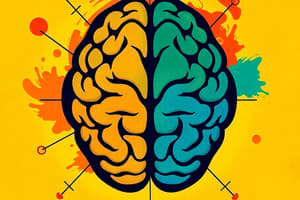Podcast
Questions and Answers
Which quadrant emphasizes logical thinking and prefers straight-to-the-point answers?
Which quadrant emphasizes logical thinking and prefers straight-to-the-point answers?
- Lower Right (Quadrant C)
- Upper Left (Quadrant A) (correct)
- Upper Right (Quadrant D)
- Lower Left (Quadrant B)
Which quadrant is characterized by a preference for organization and practical application?
Which quadrant is characterized by a preference for organization and practical application?
- Upper Left (Quadrant A)
- Lower Right (Quadrant C)
- Lower Left (Quadrant B) (correct)
- Upper Right (Quadrant D)
What is a key characteristic of learners in Lower Right (Quadrant C)?
What is a key characteristic of learners in Lower Right (Quadrant C)?
- They prioritize theoretical knowledge over practical experiences.
- They focus on abstract concepts without emotional involvement.
- They enjoy learning through physical movement and participation. (correct)
- They prefer working independently without group interaction.
Which group is often spontaneous and finds rigid environments challenging?
Which group is often spontaneous and finds rigid environments challenging?
Which quadrant requires clear instructions and struggles with concepts that lack examples?
Which quadrant requires clear instructions and struggles with concepts that lack examples?
Which quadrant is described as fun, flexible, and open-minded?
Which quadrant is described as fun, flexible, and open-minded?
Which quadrant is least engaged by data and intellectual discussions without activity?
Which quadrant is least engaged by data and intellectual discussions without activity?
Which quadrant is focused on synthesizing and creating new ideas from disparate concepts?
Which quadrant is focused on synthesizing and creating new ideas from disparate concepts?
What characteristics are typically associated with left-brained individuals?
What characteristics are typically associated with left-brained individuals?
Which profile best describes right-brained people?
Which profile best describes right-brained people?
What is the primary purpose of a mind map?
What is the primary purpose of a mind map?
How does acute stress primarily affect an athlete before competition?
How does acute stress primarily affect an athlete before competition?
What distinguishes eustress from distress?
What distinguishes eustress from distress?
In which thinking style would a team most likely use analytical skills?
In which thinking style would a team most likely use analytical skills?
Which of the following is a characteristic of chronic stress?
Which of the following is a characteristic of chronic stress?
Which thinking style is most suitable for a team facing tight project deadlines?
Which thinking style is most suitable for a team facing tight project deadlines?
Flashcards
Quadrant A (Cerebral)
Quadrant A (Cerebral)
Analytical learners who prefer logical thinking, numerical data, and clear answers.
Quadrant B (Limbic)
Quadrant B (Limbic)
Practical learners who apply knowledge, need clear instructions, and prefer examples.
Quadrant C (Limbic)
Quadrant C (Limbic)
Relational learners who enjoy group learning, body movement, and emotional sharing.
Quadrant D (Cerebral)
Quadrant D (Cerebral)
Signup and view all the flashcards
Brain Dominance Theory
Brain Dominance Theory
Signup and view all the flashcards
Analytical Learner
Analytical Learner
Signup and view all the flashcards
Practical Learner
Practical Learner
Signup and view all the flashcards
Relational Learner
Relational Learner
Signup and view all the flashcards
Left-brained person
Left-brained person
Signup and view all the flashcards
Right-brained person
Right-brained person
Signup and view all the flashcards
Acute stress
Acute stress
Signup and view all the flashcards
Chronic stress
Chronic stress
Signup and view all the flashcards
Eustress
Eustress
Signup and view all the flashcards
Distress
Distress
Signup and view all the flashcards
Analytical thinking
Analytical thinking
Signup and view all the flashcards
Practical thinking
Practical thinking
Signup and view all the flashcards
Study Notes
Intelligence and Brain Dominance
- Intelligence distinguishes individuals from others.
- Ned Herrmann's Brain Dominance Theory categorizes individuals based on dominant brain modes.
Upper Left (Quadrant A) - Analytical
- Strong logical thinkers, focusing on facts and data.
- Value numerical data, precise explanations, and explicit results.
- Prefer straightforward information and well-defined concepts.
- Might struggle with expressing emotions or personal thoughts.
Lower Left (Quadrant B) - Practical
- Organize ideas logically and apply what they learn in practice.
- Require clear instructions and practical examples to understand complex concepts.
- Prefer structured approaches with clear steps and results.
- Value practical application and often require examples.
Lower Right (Quadrant C) - Relational
- Sociable learners who prefer group settings and sharing ideas.
- Value feedback, personal connections and discussions with others.
- Enjoy learning through interaction and engaging with their environment and peers.
Upper Right (Quadrant D) - Experimental
- Curious explorers who enjoy experimentation and discovery.
- Value visual learning and conceptual thinking and exploring and synthesizing ideas.
- Prefer creative problem-solving and open-ended approaches.
Brain Dominance Theory: Practical Applications
- Individuals typically exhibit traits from multiple quadrants, not just one.
- Understanding the dominant quadrant of individuals aids in constructive communication and collaborative efforts.
Left-Brained vs Right-Brained (Legacy Theory)
- Left-brained individuals are often seen as logical, organized, and detail-oriented.
- Right-brained individuals are frequently described as creative, imaginative, and emotionally responsive.
- There is significant overlap in cognitive functions and these are not mutually exclusive.
Mind Mapping
- Mind mapping is a technique for visual organizational of information through diagram, colors, symbols etc.
- Mind maps are most effective during brainstorming activities.
Stress and its Types
- Acute Stress is short-term stress triggered by daily challenges.
- Chronic Stress is long-term and potentially damaging stress.
- Eustress is good stress that motivates individuals.
- Distress is negative stress causing exhaustion and helplessness.
Four Main Thinking Styles
- Analytical Thinking Style: Used for problem-solving, especially using data, procedures, and facts.
- Practical Thinking Style: Useful in projects with deadlines and strict schedules.
- Relational Thinking Style: Best suited for assessing policy impact on interpersonal communication.
- Experimental Thinking Style: Beneficial while brainstorming new approaches, and generating new ideas or concepts.
Studying That Suits You
Use AI to generate personalized quizzes and flashcards to suit your learning preferences.




